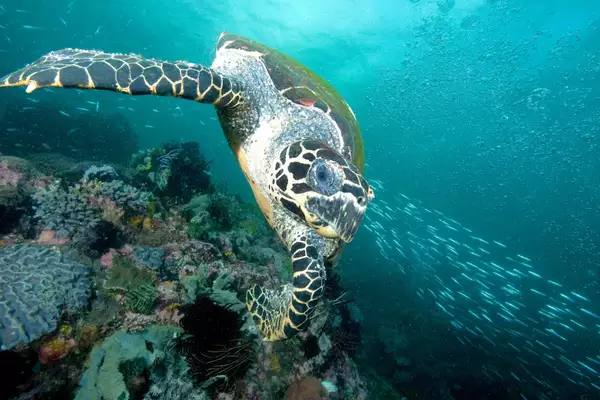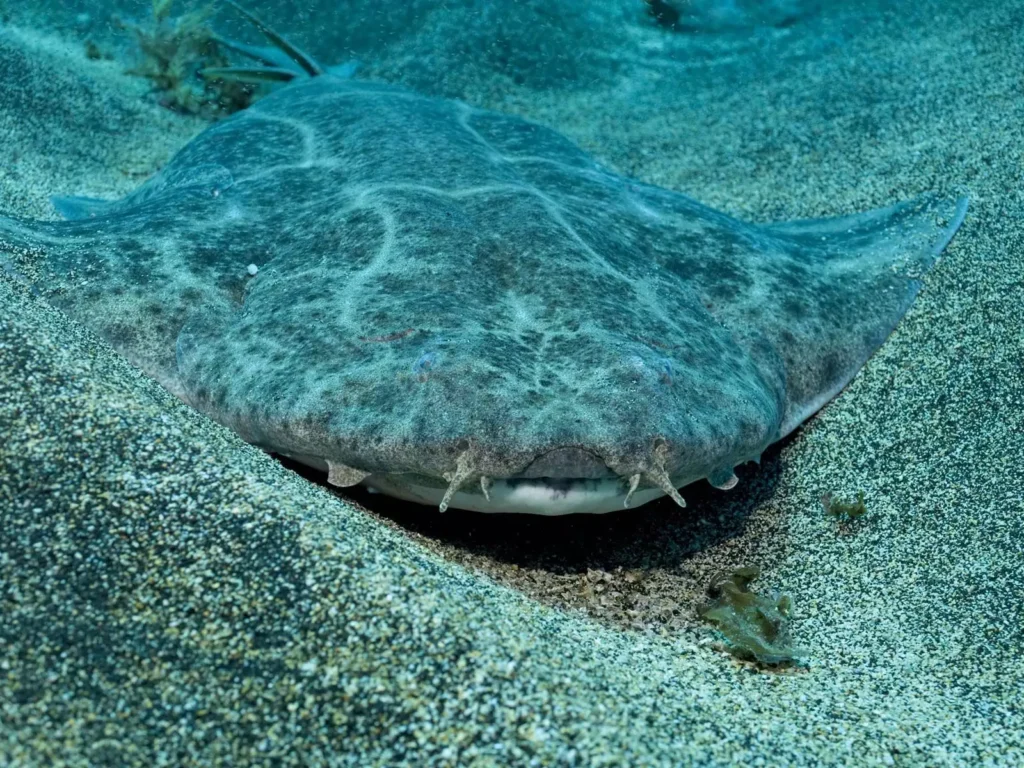The Single Species Action Plan for the conservation of the hawksbill turtle and angelshark was adopted by the 14th Conference of the Parties to the Convention on the Conservation of Migratory Species of Wild Animals (CMS COP14).
Key Outcomes of the CMS COP14:
| Agenda Items | Key Outcomes |
| Migratory Species Conservation | – Samarkand Strategic Plan for Migratory Species for 2024-2032. – New Global Guidelines addressing the impacts of Light Pollution on migratory species. |
| Species Specific Mandates | – Addition of 14 species to CMS Appendices including Eurasian Lynx, Pallas’s Cat and Sand Tiger Shark. – New Concerted Actions for six species, including Chimpanzee, Straw-colored Fruit Bat, and Blue Shark. |
| Migratory Birds | – Three new Action Plans for aquatic species, the Atlantic Humpback Dolphin, the Hawksbill Turtle and the Angelshark. – Agreement on Central Asian Flyway (CAF) spanning 30 Range States of migratory birds. It includes the establishment of a coordinating unit in India. |
| Scientific Reports | – First-ever State of the World’s Migratory Species report. |
| New Global Initiative | – A new Global Partnership on Ecological Connectivity (GPEC) was launched. – It aims to ensure that ecological connectivity is maintained, enhanced, and restored in critical areas for migratory species. – Belgium, France, Monaco, and Uzbekistan are CMS Parties supporting GPEC. |
About Hawksbill Turtle:
- The hawksbill turtle (Eretmochelys imbricata) is renowned for its stunning and colourful shells.
- It is found in tropical waters globally, including coral reefs, rocky areas, lagoons, mangroves, oceanic islands, and shallow coastal regions.
- It is characterized by a narrow head and a sharp, bird-like beak that aids in reaching into cracks and crevices for food.
Physical Characteristics:
- Adults weigh between 100-200 pounds (45 – 90 kg) and reach lengths of 2-3 feet.
- Known for their specialized diet, hawksbills feed almost exclusively on sponges.
Behaviour and Nesting:
- Solitary nesters and hawksbills nest in low densities on small scattered beaches.
- Adult females are well adapted for crawling over reefs and rocky areas to reach secluded nesting sites.
- They nest approximately 4 times per season at 2-week intervals, laying around 140 eggs per nest.
Distribution:
- Inhabit tropical and some sub-tropical regions in the Atlantic, Pacific, and Indian Oceans.
- Major populations found in the Caribbean Sea, Seychelles, Indonesia, Mexico, and Australia.
Threats:
- Population declined over 80% in the last century due to the trade in their beautiful carapace or “tortoiseshell.”
- Carapace used for jewellery, combs, brushes, and in furniture, leading to illegal international trade.
- Other threats include destruction of nesting and feeding habitat, pollution, boat strikes, coastal development, entanglement in fishing gear, consumption of meat and eggs, and destructive fishing practices like dynamite fishing.
Conservation Status:
- IUCN Red List: Critically Endangered
About Angelshark:
- An angelshark belongs to the genus Squatina, characterized by flattened bodies and wide pectoral fins, resembling rays.
- The genus is exclusive to its family, Squatinidae, and order Squatiniformes, with a global distribution in temperate and tropical seas.
- Currently, there are twenty-three known species of angelsharks.
Habitat:
- Angelsharks are found worldwide, primarily in shallow temperate or tropical seas.
- However, one species is known to inhabit deeper waters, reaching depths of up to 1,300 meters.
Predatory Behavior:
- Specialized Ambush Predators: Angelsharks exhibit a unique predation style for sharks, characterized by ambush tactics.
- Extensible Jaws: Equipped with extensible jaws and long, needle-like teeth, they swiftly snap upwards to capture prey.
- Burial Technique: They bury themselves in sand or mud, patiently lying in wait for prey, which includes fish, crustaceans, and various mollusk species.
Description and Biology:
- Distinctive Body Structure: The front part of their bodies is wide and flattened, while the back part is more muscular. Eyes and spiracles are located on the top, and five gill slits are on their back.
- Fins: Both pectoral and pelvic fins are large and held horizontally. There are two dorsal fins, but no anal fin. Notably, the lower lobe of the caudal fin is longer than the upper lobe.
- Size: Most angelshark species grow to about 1.5 meters, with the Japanese angelshark reaching up to two meters.
- Reproduction: Angelsharks are ovoviviparous, giving birth to live young, and can have up to 13 pups at a time.
Behaviour and Interaction:
- Potentially Harmful: Despite their bottom-dwelling nature and seemingly harmless appearance, angelsharks can deliver painful bites if provoked.
- Provocation Triggers: Biting may occur if a diver approaches the head or grabs the tail, highlighting their defensive response to perceived threats.
Conservation Status:
- IUCN Red List: Critically Endangered
Ref: Source
| UPSC IAS Preparation Resources | |
| Current Affairs Analysis | Topperspedia |
| GS Shots | Simply Explained |
| Daily Flash Cards | Daily Quiz |




